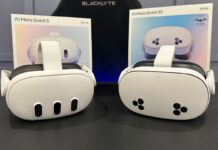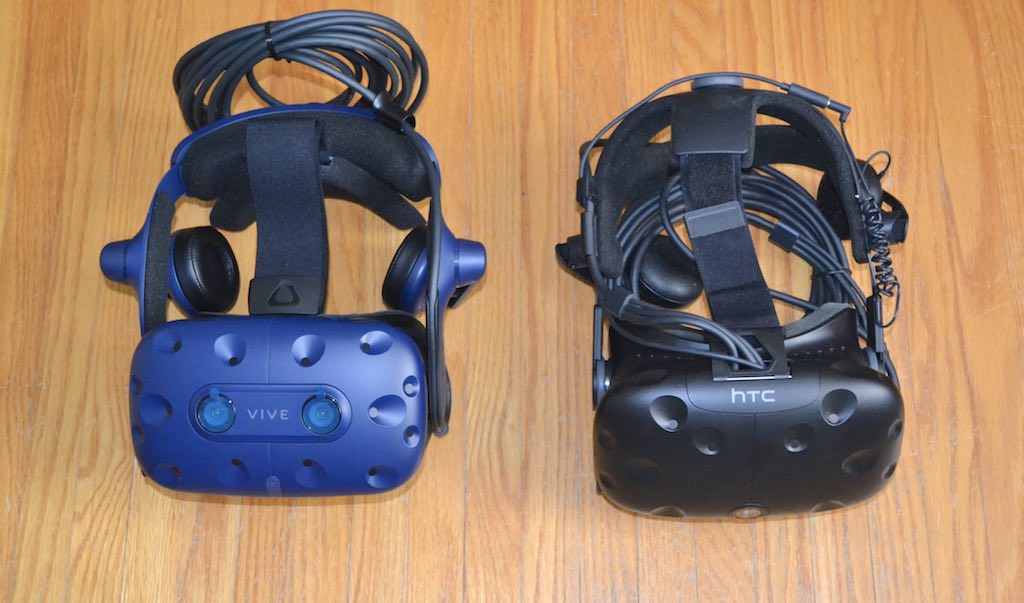
HTC is in a pretty interesting position at the moment, with two of the most compelling virtual reality headsets available both carrying its logo. The HTC VIVE has been a top choice as a high end VR experience since its release in 2016, and this April, the company released the VIVE PRO, its new flagship VR headset. You can find articles on the Best Buy blog discussing each individually: I reviewed the VIVE a while back and Dave Neufeld recently took a detailed look at the VIVE PRO. With both VIVE models still available, the question has to be asked: what’s the difference between the two?
I had the opportunity to look over the two VIVE headsets and their respective accessories, so here are the answers you might be looking for.
Unboxing: the VIVE PRO is blue …
There is a significant price difference between the two headsets (the VIVE PRO is cutting edge and HTC lowered the price of VIVE when the new flagship headset arrived), but other than that, the most striking difference between the two—at least from a distance—is that the VIVE PRO is blue instead of black … So are the controllers that were included in the VIVE VR PRO kit.
However, a closer examination soon shows the differences are more than skin deep.
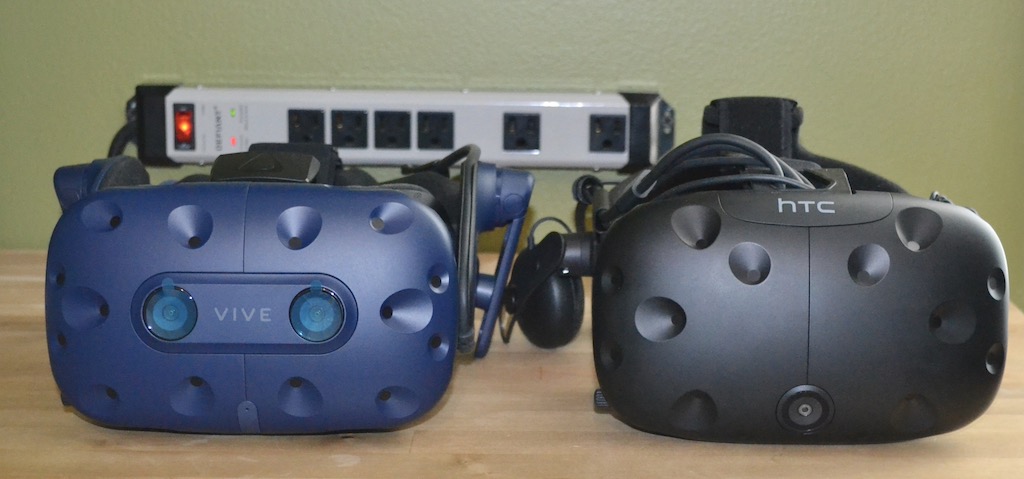
Higher resolution
The single biggest difference between the headsets is the huge boost in display resolution for the VIVE PRO. Its dual AMOLED displays each get 1440 x 1600 pixel resolution. That’s a density of 615 pixels-per-inch, and 78% more pixels than the VIVE. It means the virtual world is sharper than ever.
Two cameras instead of one
THE HTC VIVE has a single front-facing camera that can be activated to give you a glimpse of the real world without removing the headset. The VIVE PRO has two cameras and they have upgraded capabilities. Support for the cameras in VR software is up to developers, but HTC says the VIVE PRO cameras can be used for motion tracking, or to scan the space you stand in to integrate it into the virtual world.
Integrated headphones with 3D spatial audio
The HTC VIVE in these photos is equipped with the optional Deluxe Audio Strap, which includes integrated headphones. The VIVE PRO gets integrated headphones as standard equipment, and they support 3D spatial audio that significantly bumps up the immersion factor.
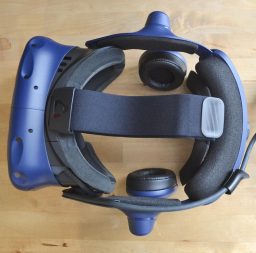 More comfortable and easier to adjust
More comfortable and easier to adjust
The original, stock, VIVE headset uses straps and velcro fasteners. They meet the requirements for adjustability, but they’re a little inconvenient. Putting the VR helmet on securely and removing it could be a little bit of a production. If you have pets, you know big strips of velcro turn into a fur magnet as well. The VIVE PRO has a much easier to adjust system that uses padded, form-fitting plastic instead, with a dial at the back to tighten it. That’s similar to the setup in the Deluxe Audio Strap. The new headset is also a little more comfortable to wear, and the front goggles portion doesn’t feel quite as heavy.
Improved cable management
Part of the reason the new headset is more comfortable and more balanced is that HTC put considerable effort into cable management. In particular, the big bundle of cables that were positioned from the top of the wearer’s head to the middle top of the goggles has been replaced in the VIVE PRO with a slim cable neatly routed around the left side of the headset before connecting to the left side of the goggles. There’s still an “umbilical” cable connecting to the Link Box (the hub between the headset and your PC), but it’s not nearly as intrusive.
Both the VIVE and VIVE PRO will also support the optional VIVE Wireless Adapter for untethered operation, when it arrives later this year.
Increased virtual reality coverage area
The VIVE PRO supports the latest Steam Base Station 2.0 tracking stations. That gives it the ability to use up to four base stations instead of the two used by the original VIVE. And that lets you double the maximum virtual reality coverage to an area of 10m x 10m (if you have a space that big), with improved multi-player support.
 VIVE owners can upgrade to VIVE PRO and keep their accessories
VIVE owners can upgrade to VIVE PRO and keep their accessories
One of the nice things about HTC’s approach with the VIVE PRO is that the company kept backwards compatibility in mind between its two headsets. Only the VIVE PRO supports the new Base Station 2.0, but it can still be used with existing VIVE Base Stations. The pro controller is blue and has a new sensor to support Base Station 2.0 tracking, but physically and functionally it is exactly the same and the VIVE PRO is compatible with the visually identical original controllers. If you’re considering an upgrade to the VIVE PRO from an existing VIVE setup, you only need to buy the standalone headset itself to get up and running.
But you may need a new computer …
I’m going to correct myself a little bit on what I just said. There is a possibility you may need to upgrade your PC (or video card) in order to use the VIVE PRO. The original connected to your computer via HDMI. But HTC switched to DisplayPort (1.2 or newer) for the VIVE PRO. You may be able to use an adapter cable if your PC only has HDMI, but I would check user forums first. And while HTC hasn’t changed the minimum PC requirements from the original, if your current system is struggling with frame rates, adding 78% more pixels to the mix is going to tax it even further.
Bottom line: “best and better”
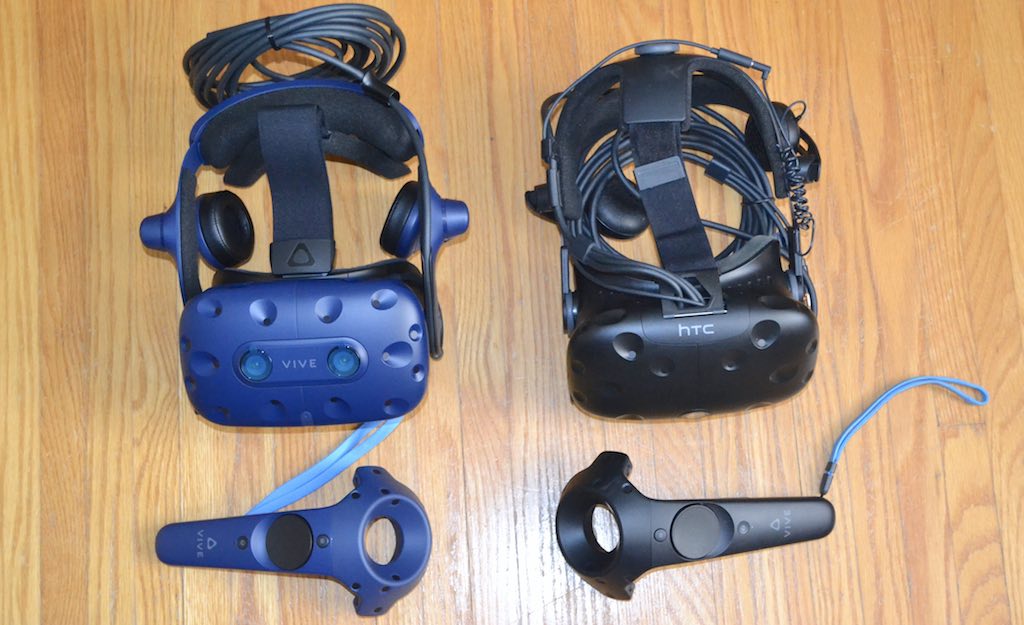
Don’t take the word “best” to mean the VIVE is literally the best VR headset around. But it’s certainly up and there and realistically—even today—it offers one of the best virtual reality experiences. But for those who want to take VR to the next level and are wiling to pay the extra, then the VIVE PRO builds on everything the VIVE offers, and makes it even better.
You can find both of these virtual reality headsets at Best Buy, along with models from competing companies, accessories like controllers and the high powered gaming PCs you’ll need to enjoy the most of your VR experience.


